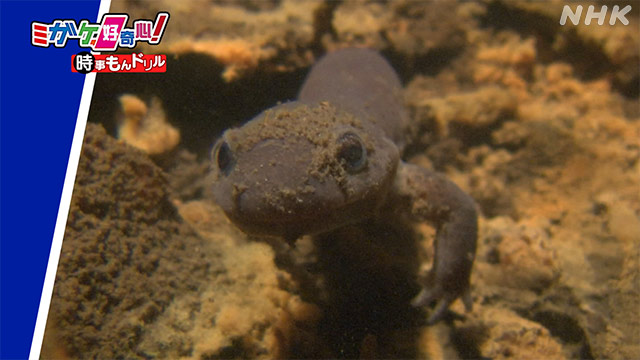New species one after another!
Salamander Jan 26 16:16
In recent years, there are organisms that have been discovered one after another in Japan.
It is said that the identification of new species, which has become possible due to advances in technology, is also important in terms of ensuring biodiversity.
This time, I would like to talk about precious creatures that live in Japan.
Challenge the problem!
First, let's look at the entrance exam questions.
Organisms that live and grow only in problematic
areas are called "endemic species." Select two that match the characteristics of the area and organisms where "endemic species" are likely to occur.
A. Areas with long coastlines and no high mountains, making it easy for organisms to migrate
b. Areas with a warm climate with high rainfall and a large number of living organisms C. Areas
far from the continent where small islands gather
D. Organisms that give birth to a large number of children at once E. Organisms
with low ability to move
(Joshigakuin Junior High School 2017 Science revised title)
The correct answer is U and O.
Since the Japanese archipelago where we live is an island nation, there are many "endemic species" that are unique to the region.
Among such "endemic species", the one that has recently been discovered one after another is the "salamander"!
We investigated unexpectedly unknown ecology and the path to discovering new species.
What is a salamander
Salamanders are amphibians like frogs and newts, and are carnivorous animals that eat insects and earthworms.
They mainly inhabit East Asia such as China, Japan, and the Korean Peninsula, and 96 species have been confirmed.
(As of December 2022, salamander family)
It prefers mountain streams with clean water, and its habitat is said to be an indicator of the preservation of diverse ecosystems.
In Japan, they live in a wide area except for Okinawa and the Amami Islands, and there are 48 species of them!
It is a "treasure trove of salamanders" where you can see half of the world's species.
Due to its narrow migration range, each region has undergone its own evolution, and recently new species have been discovered one after another in Japan.
We interviewed Natsuhiko Yoshikawa, a salamander researcher and researcher at the National Museum of Nature and Science.
Mr. Yoshikawa:
"Until around 2000, about 20 species of Japanese salamanders were known, but now there are nearly 50 species."
Yoshikawa has been involved in five of these discoveries.
Last year, I discovered something new...
What is the new species Homurahakone salamander?
Its name is "Homura Hakone Salamander"
, which inhabits the area from Kyoto Prefecture to Ishikawa Prefecture and the mountainous areas of the Kii Peninsula.
I thought that some people might think of that anime when they heard "Homura", so I asked a question...
Did you get the inspiration for "Demon Slayer: Kimetsu no Yaiba"?
Yoshikawa:
“I hadn’t read ‘Kimetsu no Yaiba’ and had been thinking about it for years, but…”
It seems that he had already decided before the anime and wanted to put the flame-like pattern on his back into the name, so he named it "Homura", which means flame.
Now, what was the decisive factor that Mr. Yoshikawa was convinced that it was a new species this time?
Mr. Yoshikawa:
“(Homura Hakone salamander) was thought to be the same species as the Hakone salamander, and they were confused. I was
The left of the image is Hakone salamander.
It was named after it was discovered in Hakone, and is now found in a wide area of Honshu.
And the one on the right is the new one.
They look very similar, don't they?
In the past, the only way to tell them apart was by their appearance.
In recent years, however, improvements in DNA analysis technology have made it possible to distinguish differences at the genetic level in greater detail, leading to the discovery of new species.
In addition to DNA analysis, Mr. Yoshikawa has steadily collected samples of 300 individuals and has continued to compare them with conventional ones.
As a result of research that took 10 years, it was revealed that Hakone salamanders, which had been thought to be a single species, can be subdivided into 7 species.
Then, in February of last year, a new species of "Homura Hakone Salamander" was announced in an international specialized magazine.
Mr. Yoshikawa:
“It feels like a weight has been lifted from my shoulders because I have been able to announce a new species that has been pending for a long time.In the future, I will have to think about research and conservation of its habitat, so this is still the starting line. I wonder."
Salamander in danger of extinction
New discoveries of Japanese salamanders are being made one after another, but in fact, many species are now in danger of extinction.
As many as 41 species, or 85%, are on the Red List as endangered species.
The factors vary from species to species.
Mr. Yoshikawa says that it is important to correctly recognize the differences between species in order to protect living things from the danger of extinction and ensure "diversity."
Mr. Yoshikawa:
"If it were to be confused with another species with a wider distribution, people would say, 'Even if it's gone in this area, it's fine because it's over there, right?' Recognizing that it is a rare species is the first step in protecting it.”
I would like to start by getting interested in the creatures that live in our area.
In "Migake, curiosity!" of "Weekly Maruwaki News" (broadcast at 8:25 am on Sundays), we will delve into the news every week on topics such as current affairs presented in the entrance examination.
Let's think together about "why?"
On the corner homepage, you can also review the past.
Please take a look at the link below.
https://www3.nhk.or.jp/news/special/maruwaka-migake/

